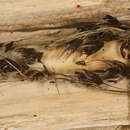Associations
provided by BioImages, the virtual fieldguide, UK
In Great Britain and/or Ireland:
Foodplant / pathogen
sorus of Ustilago avenae infects and damages live ovary of Arrhenatherum elatius
Remarks: season: early 6+
Other: major host/prey
Foodplant / pathogen
sorus of Ustilago avenae infects and damages live ovary of Avena sativa
Other: minor host/prey
Comprehensive Description
provided by North American Flora
Ustilago perennans Rostr. Overs. K. Danske Vid. Selsk
Forh. 1890 : 15. Mr 1890.
Cintractia Avenae Ellis & Tracy, Jour. Myc. 6: 77. S 1890. (Type from Mississippi, on Arrhenatherum. elatius.)
Sori in spikelets, more or less destroying the basal and inner parts, sometimes even running down on pedicels, oblong, about 3-8 mm. in length, with dusty, olive-brown sporemass ; mycelium perennial in perennial parts of host ; spores chiefly subspherical or spherical, occasionally ovate to ellipsoidal, usually lighter-colored on one side, more or less minutely echinulate especially on the lighter side, 5-8 M in length.
Arrhenatherum elatius {A. avenaceum), Connecticut, Illinois, Indiana, Iowa, Mississippi, New York, Ohio, Vermont, Wisconsin. , ,. ,
Type locality • Europe, on Avena elatior {^Arrhenatherum elattus). Distribution : New England to Iowa and Mississippi ; also in Europe and Asia
- bibliographic citation
- George Perkins Clinton. 1906. USTILAGINALES; USTILAGINACEAE, TILLETIACEAE. North American flora. vol 7(1). New York Botanical Garden, New York, NY
Comprehensive Description
provided by North American Flora
Ustilago levis (Kellerm. & Swingle) Magn. Abh. Bot. Ver
Prov. Brand. 37 : 69. 1896.
Ustilago Avenae levis Kellerm. & Swingle, Ann. Rep. Kan. Agr. Exp. Sta. 2 : 259. 1890.
? Ustilago Kolleri Wille, Bot. Notiser 1893 : 10. 1893. (Type from Norway, on Avena sativa.)
Sori in spikelets, forming a black-brown adhering spore-mass, sometimes small and entirely concealed by the glumes but usually evident and destroying inner and basal parts ; spores lighter-colored on one side, subspherical to spherical or rarely more elongate, smooth, 5-9^, the most elongate rarely 11 /i, in length.
On Poaceae :
Avena saliva, Connecticut, Illi ncn s. Iowa. Kansas, Maine, New Hampshire, North Carolina, Ohio, South Dakota, gtoPj Washington, West Virginia, Wisconsin ; Nova Scotia. Type locality : Kansas, on Avemt sahva.
Distribution : Nova Scotia to North Carolina, Utah, and Washington ; also in Europe.
- bibliographic citation
- George Perkins Clinton. 1906. USTILAGINALES; USTILAGINACEAE, TILLETIACEAE. North American flora. vol 7(1). New York Botanical Garden, New York, NY
Comprehensive Description
provided by North American Flora
Ustilago avenae (Pers.) Jens. Charb. Cereales 4. 1889
Uredo segetum Avenae Pers. Tent. Disp. Fung. 57. 1797. Ustilago segetum Avenae Jens. Om Korns. Brand 61. 1888. Ustilago Avenae i.foliicola Almeida, Revista Agron. 1 : 20. 1903.
Sori in spikelets, forming a dusty olive-brown spore-mass, about 6-12 mm. long by half as wide, usually rather completely destroying floral parts, eventually becoming dissipated, rarely in leaves ; spores lightercolored on one side, subspherical to spherical though often more elongate, minutely echinulate, 5-9 /^ in length.-
On Poaceae :
Avena fatua California. . Connecticut, Idaho, Illinois, Indiana, Iowa, Kansas,
^ '''Maine MataS Mississippi, Missouri, Montana Ne-
Ma NeTSshfre, New Jersey, New Mexico, New York, North Carohna, North * Dakota, Ohio, Oklahoma, Rhode Island, South Dakota, Tennessee, Texas, Vermont, Washington, West Virginia, Wisconsin, Wyoming; Nova Scotia.
Type locality : Europe, on Avena sativa.
Distribution : Coextensive with the cultivation of oats.
- bibliographic citation
- George Perkins Clinton. 1906. USTILAGINALES; USTILAGINACEAE, TILLETIACEAE. North American flora. vol 7(1). New York Botanical Garden, New York, NY
False loose smut
provided by wikipedia EN
False loose smut is a fungal disease of barley caused by Ustilago nigra. This fungus is very similar to U. nuda, the cause of loose smut, and was first distinguished from it in 1932.[2]
Symptoms
The disease is not apparent until heading, at which time, smutted heads emerge slightly earlier than healthy heads. At first, each smutted head is covered by a delicate, paperlike, grayish membrane. These membranes break shortly after the smutted heads have emerged and expose a dark brown to black, powdery mass of spores. This spores are easily dislodged, leaving only the bare rachis.[3]
Disease cycle
The disease cycle of Ustilago nigra is similar to that of U. hordei, the cause of covered smut of barley. The teliospores survive on the surface or in the soil. In some cases, the teliospores that are deposited under the hull, may germinate immediately. The mycelium then grows into the lower layers of the seed and then remains dormant until seed germination.
Infection of seedling occurs between germination and emergence. Infection can occur from seed-borne teliospores or by teliospores residing in the soil. Relatively dry soil at temperatures of 15–21 °C, are most favorable for infection. The invading mycelium becomes established within the growing point. As the plant enters the boot stage, the mycelium grows rapidly into the floral tissue which is converted to masses of black teliospores. Teliospores are disseminated by wind or during combining. The teliospores may remain viable for several spores.[2]
Management
The incidence of false loose smut can be reduced by using clean seed, treated seed and resistant cultivars.
References
-
^ "Index Fungorum - Names Record". www.speciesfungorum.org. Retrieved 2008-03-16.
-
^ a b Mathre, D.E. (1997). Compendium of barley diseases. American Phytopathological Society. pp. 120 pp.
-
^ Martens, J.W.; W.L. Seaman; T.G. Atkinson (1984). Diseases of field crops in Canada. Canadian Phytopathological Society. pp. 160 pp.

- license
- cc-by-sa-3.0
- copyright
- Wikipedia authors and editors
False loose smut: Brief Summary
provided by wikipedia EN
False loose smut is a fungal disease of barley caused by Ustilago nigra. This fungus is very similar to U. nuda, the cause of loose smut, and was first distinguished from it in 1932.
- license
- cc-by-sa-3.0
- copyright
- Wikipedia authors and editors

